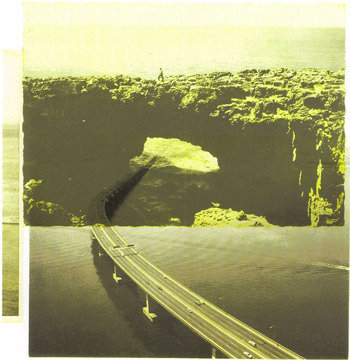Building as Everydayness
dal 14/1/2012 al 10/3/2012
Segnalato da
Antonia Carrara
Chloe Dugit-Gros
Raphael Grisey
Thomas Klimowski
Julia Rometti
Victor Costales
Estelle Nabeyrat
14/1/2012
Building as Everydayness
Scaramouche (new location), New York
A group of artists living and working in Paris. Each of the artists utilizes architecture and the built environment as a starting point for exploring Modernist icons, often through the lens of critical theory.

Curated by Estelle Nabeyrat
Antonia Carrara,
Chloé Dugit-Gros,
Raphaël Grisey,
Thomas Klimowski,
Julia Rometti & Victor Costales
Scaramouche is pleased to present the exhibition, Building as Everydayness, uniting a group of artists living and working in Paris. Each of the artists utilizes architecture and the built environment as a starting point for exploring Modernist icons, often through the lens of critical theory. Working with a variety of media including sculpture, collage, video, and installation, the artists explore everydayness as developed by philosopher Michel de Certeau in The Practice of Everyday Life (1980). In his writings, de Certeau outlined the ways individuals navigate the world around them through the most ordinary of means, including reading, walking, cooking, and talking. For de Certeau, the smallest practices can allow individuals to become active participants through "an art of manipulating and enjoying" everyday life. The exhibition focuses on everydayness as a conceptual tool to reconsider architecture and Modernist icons, away from utopian roots and with a practical perspective in the present-day, as buildings are constantly rethought and adapted by the individuals who inhabit them.
Raphaël Grisey's video Minhocão [The Big Worm] follows a car as it drives through a 1940s Rio de Janeiro housing complex of the same name. Loudspeakers attached to the car's hood broadcast a text by Eduardo Affonso Reidy, the site's architect. The ballet of the driving car, combined with interviews, sound extracts, and scenes of the housing complex in its current state of ill-repute, produce a portrait of a major modernist building, and raise issues about patrimony and memory in social housing. Like Grisey, Antonia Carrara's work focuses on present-day ruins of modernist architecture. In Carrara's video Secret Portrait with W.B., a young man coincidently named Walter Benjamin (like the Frankfurt School critical theorist) gives a guided tour of artists' residences built on Comacina Island, Italy, commissioned by Mussolini in the 1930s. Although never inhabited, the buildings were recently renovated. A voice-over expounds on the relationships between history and nature, the rational and irrational. Chloé Dugit-Gros' work rearticulates the relationship between language, image, and the visual signal, often by combing the codes of urban culture to produce new narratives. Inspired by architectural motifs and their utopian potential, Dugit-Gros will create a new, site-specific installation relating to the geographical and spatial context of the gallery. Thomas Klimowski's Patterns series consists of collages that bring to light similarities between disparate landscapes, time-periods, and built environments. His work reveals iconographic semblances through observations of hard-edged geometric motifs and images of the natural and denaturalized world. Julia Rometti & Victor Costales' series of printed images relates to their previous work Without Rain: partial nights, aerial days, a book comprised of postcards depicting North and South American environments. Randomly punctuated by 20th century interventions into the landscape, including skyscrapers and twisting highways, these aleatory settings lack the idyllic qualities usually associated with nostalgic souvenirs.
Antonia Carrara (Italy, 1982) received her Masters in Fine Arts from Ecole Nationale Supérieure des Beaux-Arts Paris. Recent exhibitions include De Hallen, Haarlem; Fons Welters Gallery, Amsterdam; Borges Cultural Center, Buenos Aires; and Fabbrica del Vapore, Milan. Chloé Dugit-Gros (France, 1981) received her Masters in Fine Arts from the Ecole Nationale Supérieure des Beaux-Arts Paris. Recent exhibitions include Galerie Dohyang Lee, Paris; Galerie HO, Marseille; Wiels Project Room, Brussels; and PSM Gallery, Berlin. Raphaël Grisey (France, 1979) received degrees from the Universität der Künste, Berlin and École Nationale Supérieure des Beaux-Arts Paris. Recent exhibitions and screenings include NO.W.HERE, London; Centre Georges Pompidou, Paris; MAM-Museum of Modern Art, São Paulo; Arnolfini, Bristol; and Haus der Kultur der Welt, Berlin. Thomas Klimowski (France, 1978) received his Masters in Fine Art from École Nationale Supérieure des Beaux-Arts Lyon. Recent exhibitions include Station Vastemonde, Saint-Brieuc; 5th Biennial of Contemporary Art, Bourges; Astérides, Marseille; and Centro 104, Belo Horizonte. Julia Rometti (France, 1975) & Victor Costales (Belarus, 1974) have been producing collaborative work since 2007. Recent exhibitions include The Royal Institute of Art, Stockholm; Justmad, Madrid; The David Roberts Art Foundation, London; Capacete 29th Biennial, São Paulo; and Jousse Entreprise, Paris.
Estelle Nabeyrat is a Paris-based curator and art critic. A graduate of La Sorbonne and The University of Leipzig, she served as curator-in-residence at the Palais de Tokyo, Paris and participated in the Brown Foundation Fellows Program of the Museum of Fine Arts Houston, and the Capacete residency, Rio de Janeiro. Recent exhibitions include Palais de Tokyo, Paris; Galerie La Box, Bourges; and Dallas Contemporary, Dallas.
Image: Julia Rometti & Victor Costales, Aerial Yellow Days II, 2011 (detail from diptych), offset print, 13.4x9.4 in.
OPENING: sunday, January 15, 4 - 6pm
Scaramouche (new location)
52 Orchard Street - NY



